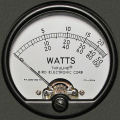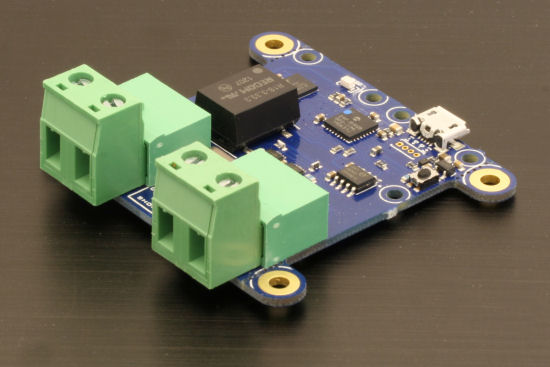 We know that some of you are impatiently waiting for it. The Yocto-Watt is now available! This new module enables you to measure by USB an electrical consumption, both with direct and with alternating current.
We know that some of you are impatiently waiting for it. The Yocto-Watt is now available! This new module enables you to measure by USB an electrical consumption, both with direct and with alternating current.
The Yocto-Watt is a double width module. It has on one side the traditional USB socket of all Yoctopuce modules, and on the other side two big terminals for large diameter wires. With this new module, you can measure the voltage at the bounds of an electrical appliance, the current flowing through the appliance, and naturally, you can also measure its electrical consumption.

The latest Yoctopuce sensor: the Yocto-Watt
The Yocto-Watt is an isolated module, which means that the USB part, connected to your computer, is electrically isolated from the measuring part. You can thus measure the consumption of appliances connected to the mains without risking to fry your computer.
Talking about the mains, the Yocto-Watt works just as well with direct current as with alternating current. This nuance is important: when they work with alternating voltage, appliances containing windings, such as transformers or motors, induce a current/voltage shift. These appliances are qualified as inductive loads. Computing the consumptions of such appliances becomes therefore more complicated than a simple voltage * current multiplication. Not only can the Yocto-Watt compute the consumption correctly, it can also provide you with the value of the observed current/voltage shift, called Cos φ or power factor. A purely resistive load has a 1.0 Cos φ, an inductive load has a Cos φ below 1.
The Yocto-Watt can also compute the consumption of an appliance over time. Indeed, it has a built-in Watt/hour counter and a built-in chronometer which are synchronized. This means that at any time you can know which quantity of energy was absorbed over which duration.
Naturally, as most Yoctopuce sensors, the Yocto-Watt contains a data logger allowing it to store measured values, for later retrieval. In short, the Yocto-Watt will certainly help you a lot if you wish to optimize your electrical consumption, or if you are simply curious to know which appliance consumes what and when at home.
Perhaps are you nevertheless wondering if the only difference between a Yocto-Watt at EUR 73 and a wattmeter available in a supermarket for EUR 25 is the USB interface? We have prepared a comparison between a few devices to answer this question. The Lutron Wattmeter was our reference to validate the workings of the Yocto-Watt with strong currents. We then included in the comparison small wattmeters available for the general public and the Yocto-Watt. Here are their respective characteristics to start with:
| Model | DW-6090A | EMU 1.24 | MP-A 084SW1 | Yocto-Watt |
|---|---|---|---|---|
| Vendor | Lutron | EMU Elektronik AG | Migros | Yoctopuce |
| AC voltage range | 0.1 - 600 V~ | 176 - 256 V~ | 230 V~ | 0.1 - 250 V~ |
| AC current range | 0.01 - 10 A~ | 0.01 - 10 A~ | 0.01 - 10 A~ | 0.003 - 16 A~ |
| AC power range | 0.1 - 2560 W | 0.3 - 2560 W | 1 - 2300 W | 0.15 - 4000 W |
| DC voltage range | 0.1 - 600 V~ | n/a | n/a | 0.01 - 250 V |
| DC current range | 0.01 - 10 A~ | n/a | n/a | 0.002 - 16 A |
| DC power range | 0.1 - 2560 W | n/a | n/a | 0.001 - 4000 W |
| Interface | RS-232, screen | screen | screen | USB, API |
| Price | 300 EUR | 275 EUR | 25 EUR | 73 EUR
|
The advantage of general public appliances is to have a secured enclosure in molded plastic, with an embedded screen. On the other hand, no USB interface, no programming API. And above all, some functional limitations, as we are going to see below.
Simple test
To start with, we take a simple 400W halogen projector.
| Model | DW-6090A | EMU 1.24 | MP-A 084SW1 | Yocto-Watt |
|---|---|---|---|---|
| Vendor | Lutron | EMU Elektronik AG | Migros | Yoctopuce |
| Measured power | 406 W | 402 - 406 W | 404 - 405 W | 405 - 406 W |
| Measured voltage | 231 V~ | 228 - 229 V | 228 - 229 V~ | 225 - 232 V~ |
| Measured current | 1.76 A | 1.76 A | 1.76 A | 1.78 A |
| Power factor | 1.00 | n/a | 1.00 | 0.99 - 1.00 |
No major difference, all the measures correspond. Note that the measures of the Yocto-Watt are less averaged than in the other products, therefore they are more reactive but, on the other hand, they are somewhat less stable on alternating current.
2nd test: inductive load
We now measure a stabilized power source, without consumer.
| Model | DW-6090A | EMU 1.24 | MP-A 084SW1 | Yocto-Watt |
|---|---|---|---|---|
| Vender | Lutron | EMU Elektronik AG | Migros | Yoctopuce |
| Measured power | 15.6 W | 15 - 15.4 W | 17 W | 16 - 16.2 W |
| Measured voltage | 234 V | 228 - 229 V | 228 - 229 V | 230 - 234 V |
| Measured current | 0.083 A | 0.09 A | 0.10 A | 0.083 A |
| Power factor | 0.80 | n/a | 0.76 | 0.83 - 0.85 |
Again, the values correspond reasonably. The cheaper wattmeter seems to overestimate consumption slightly, but it stays within reason.
3rd test: low load
Let's see what happens if you connect a consumer of only 0.8W (for example an appliance in stand-by or in our case a small 5V device connected to a mobile phone charger):
| Model | DW-6090A | EMU 1.24 | MP-A 084SW1 | Yocto-Watt |
|---|---|---|---|---|
| Vendor | Lutron | EMU Elektronik AG | Migros | Yoctopuce |
| Measured power | 0.7 - 0.8 W | 0.7 W | 0 W | 0.75 - 0.83 W |
| Measured voltage | 234 V | 232 - 233 V | 232 - 233 V | 230 - 234 V |
| Measured current | 0.010 A~ | 0.01 A | 0 A | 0.005 - 0.006 A |
| Power factor | 0.33 | n/a | n/a | 0.83 - 0.85 |
The cheaper wattmeter simply doesn't see the load. Don't count on using it to optimize your energy consumptions by shutting down appliances in stand-by. If the appliance consumes less than 0.4W, even our EMU wattmeter doesn't see it, although the consumption is real. Only the big Lutron wattmeter and the Yocto-Watt detect it correctly.
We won't show DC measure comparisons, as only the Lutron wattmeter and the Yocto-Watt are able to make these measures. Simply keep in mind that with DC, the measures are always perfectly stable, and that the Yocto-Watt is the only one among these products which enables you to measure a power consumption as low as 1mW.
To conclude
Without pretending to be a general public product, the Yocto-Watt provides the possibility to perform measures with a reasonable precision on a very large range, until now only available on much more sophisticated and much more expensive products. And all this naturally with a USB connection without driver, with a programming API for the most common languages, and with an embedded data logger...


